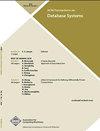分层数据上的高性能复杂事件处理
IF 2.2
2区 计算机科学
Q3 COMPUTER SCIENCE, INFORMATION SYSTEMS
引用次数: 25
摘要
虽然复杂事件处理(CEP)在所谓的大数据分析中占相当大的一部分,但目前的CEP系统只能处理结构简单的数据,并且在有效支持对结构化或半结构化信息的复杂连续查询方面能力有限。然而,类似xml的流代表了一种非常流行的数据交换形式,包括大部分的社交网络和RSS提要、金融提要、配置文件以及需要高级CEP查询的类似应用程序。在本文中,我们将通过XPath的扩展介绍在XML流上支持CEP的XSeq语言和系统,该扩展既强大又易于高效实现。具体来说,XSeq语言使用自然运算符扩展XPath,以在XML流上表示顺序模式和Kleene-*模式,同时保持对高效执行的高度适应性。事实上,XSeq是为了充分利用最近提出的可视下推自动机(VPA)而设计的,VPA可以在不影响有限状态自动机的计算吸引力的情况下实现更高的表达能力。除了效率和表达性方面的好处之外,选择VPA作为底层模型还使XSeq能够超越XML流,并且可以轻松地应用于具有顺序和层次结构的任何数据,包括JSON消息、RNA序列和软件跟踪。因此,我们将通过来自不同领域的示例说明XSeq在CEP应用程序中的强大功能,并提供有关其表达性和复杂性的正式结果。最后,我们介绍了几种用于XSeq查询的优化技术。我们的大量实验表明,XSeq为CEP应用程序带来了出色的性能:与在通用XML引擎中执行的相同查询相比,获得了两个数量级的改进。本文章由计算机程序翻译,如有差异,请以英文原文为准。
High-performance complex event processing over hierarchical data
While Complex Event Processing (CEP) constitutes a considerable portion of the so-called Big Data analytics, current CEP systems can only process data having a simple structure, and are otherwise limited in their ability to efficiently support complex continuous queries on structured or semistructured information. However, XML-like streams represent a very popular form of data exchange, comprising large portions of social network and RSS feeds, financial feeds, configuration files, and similar applications requiring advanced CEP queries. In this article, we present the XSeq language and system that support CEP on XML streams, via an extension of XPath that is both powerful and amenable to an efficient implementation. Specifically, the XSeq language extends XPath with natural operators to express sequential and Kleene-* patterns over XML streams, while remaining highly amenable to efficient execution. In fact, XSeq is designed to take full advantage of the recently proposed Visibly Pushdown Automata (VPA), where higher expressive power can be achieved without compromising the computationally attractive properties of finite state automata. Besides the efficiency and expressivity benefits, the choice of VPA as the underlying model also enables XSeq to go beyond XML streams and be easily applicable to any data with both sequential and hierarchical structures, including JSON messages, RNA sequences, and software traces. Therefore, we illustrate the XSeq's power for CEP applications through examples from different domains and provide formal results on its expressiveness and complexity. Finally, we present several optimization techniques for XSeq queries. Our extensive experiments indicate that XSeq brings outstanding performance to CEP applications: two orders of magnitude improvement is obtained over the same queries executed in general-purpose XML engines.
求助全文
通过发布文献求助,成功后即可免费获取论文全文。
去求助
来源期刊

ACM Transactions on Database Systems
工程技术-计算机:软件工程
CiteScore
5.60
自引率
0.00%
发文量
15
审稿时长
>12 weeks
期刊介绍:
Heavily used in both academic and corporate R&D settings, ACM Transactions on Database Systems (TODS) is a key publication for computer scientists working in data abstraction, data modeling, and designing data management systems. Topics include storage and retrieval, transaction management, distributed and federated databases, semantics of data, intelligent databases, and operations and algorithms relating to these areas. In this rapidly changing field, TODS provides insights into the thoughts of the best minds in database R&D.
 求助内容:
求助内容: 应助结果提醒方式:
应助结果提醒方式:


